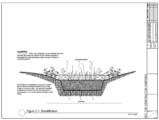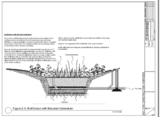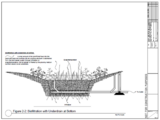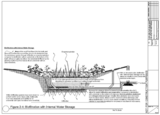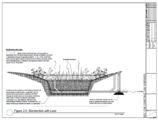
Difference between revisions of "Bioretention terminology"
m |
m |
||
| Line 1: | Line 1: | ||
| + | [[File:Determining type of infiltration SCM.png|thumb|300px|alt=flowchart for determining the type of infiltration or bioretetnion device|<font size=3>Flow chart for determining the type of infiltration or bioretetnion device.</font size>]] | ||
| + | |||
Infiltration basins and bioretention basins are terrestrial-based (up-land as opposed to wetland-based), water quality and water quantity control treatment practices with a required drawdown time of 48 hours or less. For basins within trout stream watersheds, the drawdown time is 24 hours or less due to the need to reduce discharge temperatures. | Infiltration basins and bioretention basins are terrestrial-based (up-land as opposed to wetland-based), water quality and water quantity control treatment practices with a required drawdown time of 48 hours or less. For basins within trout stream watersheds, the drawdown time is 24 hours or less due to the need to reduce discharge temperatures. | ||
Revision as of 13:45, 29 August 2013
File:Determining type of infiltration SCM.png
Flow chart for determining the type of infiltration or bioretetnion device.
Infiltration basins and bioretention basins are terrestrial-based (up-land as opposed to wetland-based), water quality and water quantity control treatment practices with a required drawdown time of 48 hours or less. For basins within trout stream watersheds, the drawdown time is 24 hours or less due to the need to reduce discharge temperatures.
Summary of factors that can be used to determine differences between infiltration basins and bioretention basins. This table corresponds with Table 1 in the adjacent flowchart.
Link to this table
| BMP | Typical position in watershed | Treatment scale | Typical storm sizes | Maximum drainage area guidelines | Maximum ponding depth guidelines | Growing medium |
|---|---|---|---|---|---|---|
| Infiltration (basin, trench, underground, dry well) | Downgradient of other water quantity or water quality control practices | Development or regional scale control | Less frequent large storm events that exceed capacity of upgradient practices | 50 acres | 4 feet | Native soil |
| Bioretention basin | Located throughout the watershed | Site scale control | Small storms (water quality events) | Typically 5 acres | Ideally 12 inches; can be up to 18 inches with appropriate design and plant selection | Engineered growing medium |
Types of bioretention basins. This table corresponds with Table 2 in the adjacent flowchart.
Link to this table
| BMP | Typical uses; advantages | Relative amount of runoff abstracted from storm sewer system | 2008 Manual terminology1 |
|---|---|---|---|
| Bioinfiltration basin | Abstracts all runoff captured in the basin that does not leave through overflow | All runoff that flows into the basin and does not overflow into an overflow structure is abstracted from the stormsewer system through infiltration or evapotranspiration. | Infiltration / recharge facility |
| Biofiltration basin with underdrain at bottom | Allows for a small amount of infiltration, at a rate compatible with underlying soils, but carries away excess waterthrough the underdrain after it has been filtered through the basin | A small amount of the runoff that flows into the basin and does not overflow into an overflow structure is abstracted from the stormsewer system through infiltration or evapotranspiration; the remainder is filtered by the growing medium but then leaves via an underdrain. | Filtration / partial recharge |
| Biofiltration basin with internal water storage (IWS) | Allows for more infiltration, at a rate compatible with underlying soils, but carries away excess water through the underdrain after it has been filtered through the basin; Internal Water Storage Zone (IWS) (1) allows for more infiltration and evaporation compared to bioretention with underdrain at the bottom; (2) improves thermal pollution abatement and nitrogen removal (longer retention time allows runoff to cool more before discharge and allows denitrification to occur under anoxic condition). | More of the runoff that flows into the basin and does not overflow into an overflow structure is abstracted from the stormsewer system through infiltration or evapotranspiration compared to bioretention with an underdrain at the bottom of the basin without an upturned elbow, because the upturned elbow increases hydraulic retention time; the remainder is filtered by the growing medium but then leaves via an underdrain with an upturned elbow. | Not included |
| Biofiltration basin with elevated underdrain | Allows for more infiltration, at a rate compatible with underlying soils, but carries away excess water through the underdrain after it has been filtered through the basin; elevating underdrain (1) allows for more infiltration and evaporation compared to bioretention with underdrain at the bottom (2) improves thermal pollution abatement and nitrogen removal (longer retention time allows runoff to cool more before discharge and allows denitrification to occur under anoxic condition). | More of the runoff that flows into the basin and does not overflow into an overflow structure is abstracted from the stormsewer system through infiltration or evapotranspiration compared to bioretention with an underdrain at the bottom of the basin, because the elevated underdrain increases hydraulic retention time; the remainder is filtered by the growing medium but then leaves via an elevated underdrain. | Infiltration / filtration / recharge |
| Biofiltration basin with liner | Impervious liner reduces or eliminates possibility of groundwater contamination; underdrain can be blocked and objectionable materials siphoned through an observation well and safely contained; often used in areas of potential stormwater “hot-spots” (e.g., gas stations, transfer sites, transportation depots,industrial complexes etc.), or areas where groundwater recharge is undesirable | None of the runoff that flows into the basin is abstracted from the stormsewer system through infiltration but some is abstracted through evapotranspiration; i.e. all of the runoff that flows into the basin without flowing into an overflow structure, and is not evapotranspired, is filtered by the growing medium but then leaves via an underdrain. | Filtration only |
1Terminology used in the 2008 Minnesota Stormwater Manual.
- Plan drawings for different bioretention devices. Click on an image for enlarged view.
